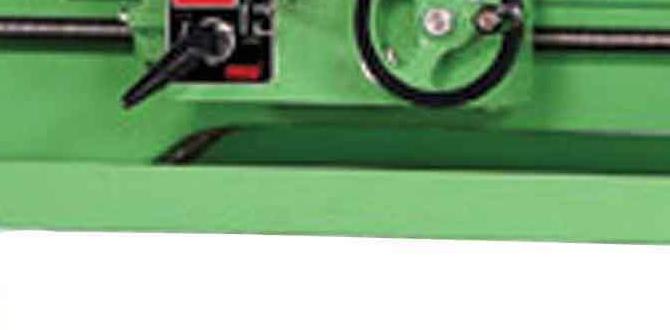Oil for lathe ways is crucial for smooth operation and longevity. Using the correct lubricant prevents premature wear on critical moving parts, ensuring accuracy and preventing costly repairs. Regular application of the proper oil is a simple yet genius maintenance step every lathe owner should master.
Welcome to Lathe Hub! If you’ve ever felt your lathe’s carriage or cross-slide moving a little… sticky… or if you’re just starting out and want to keep your machine in top shape, you’re in the right place. The ways of a lathe are its guiding paths, the surfaces that allow the carriage and tailstock to move smoothly along the bed. Keeping these pristine requires just one thing: the right oil! It sounds simple, and it is, but using the wrong stuff can cause big problems. Don’t worry, though. This guide will walk you through everything you need to know about selecting and applying oil for your lathe ways, making this essential maintenance a breeze.
Why Oiling Lathe Ways is a Genius Maintenance Move
Think of your lathe’s ways as the smooth, precise highway for its moving parts. These surfaces are designed for incredibly low friction and high accuracy. When they’re properly lubricated, everything glides effortlessly. This isn’t just about making your machine feel nice to operate; it’s fundamental to its performance and lifespan.
Untreated or poorly lubricated ways are a recipe for disaster. Metal-on-metal contact, even with carefully machined surfaces, will cause wear. This wear doesn’t just make things feel rough; it creates tiny imperfections that throw off your machining accuracy. Imagine trying to turn a perfectly round part when your carriage is juddering! Over time, this wear can become permanent, leading to expensive repairs or even a ruined machine. A simple application of the right oil is a proactive, genius maintenance strategy that prevents this damage before it starts.
The Benefits of Proper Lathe Way Lubrication
- Smoother Operation: Your carriage and cross-slide will move with buttery smoothness, making precise adjustments easier.
- Increased Accuracy: Reduced friction and wear directly translate to more precise machining results.
- Extended Machine Life: Preventing wear on these critical components significantly prolongs the usable life of your lathe.
- Preventing “Chatter”: Insufficient lubrication can contribute to vibration issues, or chatter, during cuts.
- Corrosion Protection: Many quality way oils contain rust inhibitors, protecting your valuable machine components.
- Cost Savings: Avoiding wear and tear is far cheaper than replacing worn parts or entire machines.
Understanding Lathe Way Lubricants: What Makes Them Special?
You might think, “Can’t I just use any old engine oil?” The answer is a resounding no! Lathe way oils are specifically formulated for the unique demands of machine tool slides. They have a higher viscosity and excellent tackiness, meaning they cling to the metal surfaces and don’t get squeezed out easily under pressure. This “cling” is crucial.
Traditional lubricants like motor oil are designed to flow freely to lubricate rapidly moving engine parts. Machine tool ways, however, experience slower, more deliberate movements, often with significant pressure. Way oil needs to stay put and provide a consistent film of lubrication, even when the machine is idle for extended periods or when the carriage is moved very slowly.
Key Characteristics of Good Way Oil
- High Viscosity: A thicker oil that resists squeezing out under pressure.
- Adhesive Properties (Tackiness): It “sticks” to the metal surfaces, ensuring a continuous lubricating film.
- Good Load-Carrying Capacity: Able to withstand the forces exerted on the ways.
- Rust and Corrosion Inhibition: Protects the machined surfaces from environmental damage.
- Minimal Stick-Slip: Designed to prevent the jerky, stuttering motion that can occur when a lubricated surface starts to move.
- Thermal Stability: Maintains its lubricating properties across a range of operating temperatures.
For example, the U.S. Department of Defense has specifications for machine tool lubricants, like MIL-SPEC 2105, which outline requirements for lubricants used in critical equipment. While you don’t need to be military-grade, understanding these standards highlights the importance of specialized lubricants. Reputable manufacturers like Mobil, Mobil Vactra, Shell, and Houghton all produce excellent way oils designed for this purpose.
Choosing the Right Oil: Viscosity Matters!
The most critical factor when selecting oil for your lathe ways is viscosity. This is simply a measure of how thick or resistant to flow the oil is. Way oils come in different weights or grades, typically ranging from ISO VG 32 to ISO VG 220.
The recommended viscosity will largely depend on two things:
- Your Lathe Manufacturer’s Recommendation: This is always the first place to check. Your lathe’s manual (if you have it) will specify the exact type or viscosity grade of oil they recommend.
- Operating Temperature and Machine Type: In warmer environments or for machines that experience significant heat buildup, you might opt for a slightly higher viscosity oil. For smaller, lighter machines or colder workshops, a lower viscosity oil might be sufficient.
Common Way Oil Viscosity Grades and Their Uses:
| ISO VG Grade | Common Industry Names | Typical Application | Notes |
|---|---|---|---|
| ISO VG 32 | Mobil Vactra Oil Medium, Medium Way Oil | Light-duty lathes, milling machines, drill presses, some older or smaller machines. Also suitable for hydraulic systems if specified. | Good for lighter loads and where quick response is needed. Can be prone to squeeze-out on heavier machines. |
| ISO VG 68 | Mobil Vactra Oil No. 2, Medium-Heavy Way Oil | Most common for general-purpose lathes and milling machines. Good balance of film strength and flow. | A great starting point for many hobbyist and professional machines. |
| ISO VG 150 | Mobil Vactra Oil Heavy, Heavy Way Oil | Heavier duty lathes, large milling machines, grinding machines, sliding surfaces requiring high load-carrying capacity. | Provides a very robust lubricating film, excellent for preventing stick-slip. |
| ISO VG 220 | Extra Heavy Way Oil | Very heavy industrial machinery, large planers, shaper beds, and applications with extreme loads. | Rarely needed for typical home or small shop lathes. |
As a general rule for most common metalworking lathes you’ll find in home workshops or school settings, ISO VG 68 (often labeled as “Medium” or “No. 2” way oil) is an excellent and safe choice. If you have a very small, light lathe or a very cold workshop, ISO VG 32 might be considered. For very large, heavy-duty machines, ISO VG 150 could be appropriate. When in doubt, stick with ISO VG 68 or consult your machine’s manual.
You can find excellent quality way oils from brands like Mobil (Mobil Vactra Oil series), Shell, Houghton, Klüber Lubrication, and many other industrial lubricant suppliers. Many specialized machinery dealers also offer their own branded way oils. It’s worth investing in a name-brand product to ensure quality and proper formulation. Avoid generic “lubricating oil” or “all-purpose oil” as they lack the specific properties needed for lathe ways.
How to Apply Oil to Your Lathe Ways: A Step-by-Step Guide
Now that you know what oil to use, let’s get to the how. This is straightforward, but doing it correctly is key. You’ll want to perform this task with the lathe unplugged or the power source clearly disconnected, especially if you’re interacting with moving parts or components near electrical connections.
Tools and Materials You’ll Need:
- Correct Way Oil: As discussed, ISO VG 68 is a good default.
- Lint-Free Rags: Essential for cleaning and applying oil without leaving debris. Paper towels can work, but make sure they are lint-free.
- Small Brush or Oil Can (Optional): For precise application in tight spots.
- Gloves: To keep your hands clean and prevent contamination of the oil.
The Genius Maintenance Process:
- Clean the Ways: This is the most critical first step. Before adding any new oil, you must remove all old, dirty oil, metal chips, and any grime. Use a lint-free rag, dampened very slightly with a degreaser or a bit of solvent (like mineral spirits, if you have it, but ensure it evaporates cleanly). Wipe down all the ways – the bed ways, the saddle ways, the cross-slide ways, and the compound rest ways. Work systematically, ensuring every inch of the bearing surfaces is clean. You want to see that clean metal gleam.
- Inspect for Damage: While cleaning, take a moment to visually inspect the ways. Look for any obvious nicks, deep scratches, or signs of excessive wear. Minor imperfections can often be managed with good lubrication, but significant damage might require professional attention.
- Apply the New Way Oil:
- Method 1 (Recommended): Dip a clean, lint-free rag into the way oil and wring out any excess so the rag is just damp. Then, carefully wipe a thin, even film of oil onto all the bearing surfaces of the ways. As you move the carriage or cross-slide, you’ll see where the oil travels.
- Method 2 (Precise Application): For very small amounts or hard-to-reach areas, a small oil can or a clean brush can be used to apply a few drops or brush strokes directly onto the bearing surfaces.
- Work the Oil In: Once the ways are lightly coated, move the carriage and cross-slide slowly back and forth along the entire length of their travel. Do this several times. This action helps to evenly distribute the oil, working it into microscopic valleys and ensuring it reaches all bearing surfaces under the saddle and carriage. You’ll feel the machine start to move more smoothly as the oil distributes.
- Wipe Away Excess: After working the oil in, take a clean, dry lint-free rag and wipe away any excess oil. You want a thin, consistent film, not pools of oil that will attract chips. The goal is a smooth, lubricated surface, not a greasy mess.
- Repeat for All Ways: Don’t forget to lubricate and work in the oil on all sliding surfaces:
- Bed Ways (where the saddle moves)
- Saddle (the part that carries the carriage) to Carriage ways
- Carriage to Cross-slide ways
- Cross-slide to Compound rest ways
- Tailstock ways (if applicable and they slide on the bed)
- Establish a Schedule: How often should you do this? It depends on usage. For a lathe used daily, a quick wipe and oiling might be needed every few days. For hobbyist use, doing a thorough clean and oil every week or two of use is a good habit. At a minimum, if your lathe sits for a while, give it a clean and oil before you start using it again. Consistent, light lubrication is better than infrequent heavy applications.
Common Mistakes to Avoid
Even with the best intentions, beginners can fall into a few traps. Being aware of these will save you headaches:
- Using the Wrong Oil: As mentioned, motor oil, WD-40 (which is a solvent/water displacer, not a long-term lubricant), or generic 3-in-1 oil are not suitable for lathe ways.
- Not Cleaning First: Applying new oil over dirt and chips is like putting frosting on a dirty cake – it just grinds more dirt into the surfaces.
- Over-Oiling: Too much oil attracts chips and can create a gummy mess that hinders movement and makes cleaning harder. A light, even film is ideal.
- Under-Oiling: Not enough oil means parts are running partly dry, leading to friction and wear.
- Missing Spots: Not lubricating all the bearing surfaces means some parts of your machine will wear unevenly.
- Leaving the Machine Unattended After Oiling: Always ensure the machine is powered off and safe before you start.
An Ounce of Prevention: Other Lathe Maintenance Tips
Lubricating your ways is a foundational piece of “genius maintenance,” but a well-maintained lathe involves a few other simple habits:
- Chip Management: Regularly brush or vacuum chips away from the bed and moving parts. This prevents them from being ground into the ways. A magnetic chip brush is a great tool for this.
- Protecting the Bed: Avoid dropping tools or heavy workpieces on the lathe bed. Cover it when not in use if your workshop is dusty or prone to debris.
- Checking Gibs: Gibs are adjustable strips that take up play in the ways. Learn how to adjust yours to ensure a snug, but not binding, fit. Proper gib adjustment complements good lubrication.
- Tool Post Lubrication: Don’t forget to lubricate the rotating parts of your tool post (if applicable) and the threads of your leadscrew periodically.
- Keep it Clean: A clean workshop is a clean machine. Wipe down your lathe at the end of each working session.
For more detail on general lathe care, resources like Machinery History offer insights into the design and maintenance of classic machine tools, underscoring the long-term value of proper care.
Frequently Asked Questions About Lathe Way Oil
Here are some common questions beginner machinists have about oil for lathe ways:
Q1: Can I use hydraulic oil on my lathe ways?
A: Sometimes, yes! Many hydraulic oils are formulated with excellent anti-wear additives and good viscosity indexes and are a suitable replacement if they meet the viscosity requirements (like ISO VG 46 or 68). However, true way oils often have superior “tackiness” (adhesion) to prevent squeeze-out, which hydraulic oil might lack. Always check your machine’s manual. If it specifies a particular hydraulic oil grade, use that. If not, stick to dedicated way oil.
Q2: How much oil do I really need on my ways?
A: You want a thin, consistent film covering all the bearing surfaces. It should look slightly moist, not shiny and wet or pooling. Too much oil attracts chips and dust, defeating the purpose. It’s better to apply a little, work it in, and then add a touch more if needed than to apply too much at once.
Q3: What’s this “stick-slip” I’ve heard about?
A: “Stick-slip” is a jerky, stuttering motion that can happen when a lubricated surface starts to move. The static friction is higher than the kinetic friction, causing it to “stick” for a moment and then “slip” forward. Proper way oils are formulated to minimize this by maintaining a stable lubricating film, allowing for smooth, controlled movements, which is crucial for precision machining.
Q4: My lathe is old and a bit worn. Will oiling still help?
A: Absolutely! While oil can’t fix worn-out surfaces, it can significantly improve the operation of even older machines. It will reduce further wear, provide a smoother ride, and can help compensate for minor imperfections, allowing you to achieve better accuracy than you might expect. Regular cleaning and proper lubrication are the best ways to maintain an older machine.
Q5: Can I use multi-grade oils like 10W-30?
A: No, generally multi-grade oils like 10W-30 are not suitable for lathe ways. These oils are designed for engines and contain additives that might not be compatible with machine tool slides. They also tend to have lower tackiness and may not provide the consistent, stable lubrication needed. Always use oil specifically designated as “way oil” or machine tool lubricant with the correct ISO viscosity grade.
Q6: Should I oil my ways every single time I use the lathe?
A: It depends on how rigorous your use is. For extensive use in a workshop environment, a quick wipe and re-application of oil every couple of days or even daily might be beneficial. For typical hobbyist use where each session might be an hour or two, cleaning and oiling at the start of each session, or at least every few sessions, is a good practice. The key is to ensure there’s always a protective film of oil before you begin machining.
Q7: Where can I buy good quality way oil?
A: You can typically find high-quality way oil at industrial supply stores, specialized machine tool suppliers (online or brick-and-mortar), and from major lubricant manufacturers’ distributors. Look for brands like Mobil (Vactra series), Shell, Houghton, or specific machine tool lubricant brands. Online marketplaces like Amazon also carry







